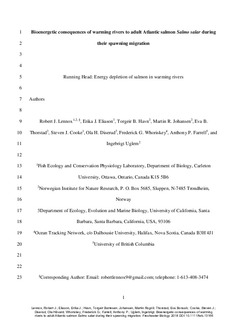| dc.contributor.author | Lennox, Robert J. | |
| dc.contributor.author | Eliason, Erika J. | |
| dc.contributor.author | Havn, Torgeir Børresen | |
| dc.contributor.author | Johansen, Martin Rognli | |
| dc.contributor.author | Thorstad, Eva Bonsak | |
| dc.contributor.author | Cooke, Steven J. | |
| dc.contributor.author | Diserud, Ola Håvard | |
| dc.contributor.author | Whoriskey, Frederick G. | |
| dc.contributor.author | Farrell, Anthony P. | |
| dc.contributor.author | Uglem, Ingebrigt | |
| dc.date.accessioned | 2018-11-14T14:09:55Z | |
| dc.date.available | 2018-11-14T14:09:55Z | |
| dc.date.created | 2018-08-23T16:14:47Z | |
| dc.date.issued | 2018 | |
| dc.identifier.issn | 0046-5070 | |
| dc.identifier.uri | http://hdl.handle.net/11250/2572890 | |
| dc.description.abstract | 1. Climate change poses a challenge to wild fishes, yet little is known about the behavioural use and metabolic consequences of thermally heterogeneous water encountered by wild salmon during their energetically demanding upstream spawning migration. 2. Temperature, body size and activity levels were modelled to predict energy depletion of salmon during their spawning migration in rivers. Archival temperature loggers revealed the thermal habitat of adult migrating Atlantic salmon (Salmo salar Salmonidae), which we used to apply bioenergetics models that estimated size-dependent temperature-driven metabolic expenditures as part of the costs of the migration. 3. Between July 16 and August 19, the mean water temperature experienced by salmon (tFISH) ranged from 11.5 to 18.0°C (14.5 ± 1.2 SD °C) and closely followed the ambient surface water temperature (tRIVER) of the river (11.5–18.5°C; 14.8 ± 1.4°C) such that the regression equation tFISH = 3.24 + 0.76 (tRIVER) was highly correlated with observations (R2 = 0.94). 4. Although temperature increases were predicted and confirmed to increase energetic costs, rates of energy depletion were more sensitive to changes in swimming speed and body size than to temperature increases in the range explored for this system. 5. We conclude that warming could contribute to changing life history phenotypes of salmon in some rivers, for example, delayed river entry or reduced probability of iteroparity, with potentially more dire consequences for smaller individuals. bioenergetics, fisheries, iButton, iteroparity, telemetry | nb_NO |
| dc.language.iso | eng | nb_NO |
| dc.subject | bioenergetics | nb_NO |
| dc.subject | fisheries | nb_NO |
| dc.subject | iButton | nb_NO |
| dc.subject | iteroparity | nb_NO |
| dc.subject | telemetry | nb_NO |
| dc.title | Bioenergetic consequences of warming rivers to adult Atlantic salmon Salmo salar during their spawning migration | nb_NO |
| dc.title.alternative | Bioenergetic consequences of warming rivers to adult Atlantic salmon Salmo salar during their spawning migration | nb_NO |
| dc.type | Journal article | nb_NO |
| dc.type | Peer reviewed | nb_NO |
| dc.description.version | acceptedVersion | nb_NO |
| dc.rights.holder | © 2018 John Wiley & Sons Ltd | nb_NO |
| dc.subject.nsi | VDP::Zoologiske og botaniske fag: 480 | nb_NO |
| dc.subject.nsi | VDP::Zoology and botany: 480 | nb_NO |
| dc.source.journal | Freshwater Biology | nb_NO |
| dc.identifier.doi | 10.1111/fwb.13166 | |
| dc.identifier.cristin | 1604123 | |
| dc.relation.project | Andre: Norwegian Environmental Agency | nb_NO |
| dc.relation.project | Andre: Canada Research Chairs | nb_NO |
| dc.relation.project | Norges forskningsråd: 216416 | nb_NO |
| dc.relation.project | Andre: Natural Sciences and Engineering Research Council of Canada | nb_NO |
| cristin.unitcode | 7511,3,0,0 | |
| cristin.unitname | Avdeling for akvatisk økologi | |
| cristin.ispublished | true | |
| cristin.fulltext | postprint | |
| cristin.qualitycode | 1 | |
